The Checker Maven
Shardlow: Checker Friendy?

Shown above is what is now a pub called The Clock Warehouse in Shardlow, Derbyshire, England. The pub is said to be dog-friendly. We're not quite sure what that means. We would rather have heard that the pub was checker (draughts) friendly.
Today, we consider a problem by a checkerist named Shardlow who didn't come from England, but from Marshall, Minnesota. What was his connection, if any, with the town in England? Most likely there is none, though we'll probably never know.
Mr. F. C. Shardlow published a number of problems in various newspapers; the one below appeared in The Winnipeg Free Press in 1938. All we were able to turn up about the author was that his full name was Frederick Cromwell Shardlow, that he was born in 1874, passed on in 1948, and had a wife and two daughters. We didn't find anything additional about his checker career, although he obviously must have been quite good.
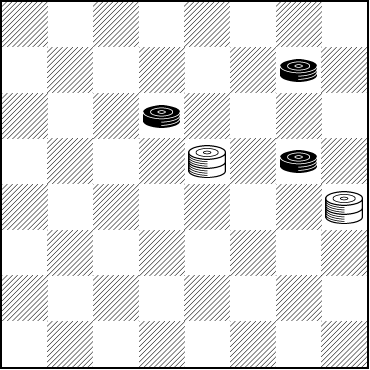
WHITE
White to Play and Win
W:WK15,K20:B8,10,16
A checker friendly problem? We think so. Try to solve it, and then give a friendly click of the mouse on Read More to see the solution.![]()
Summer's End
It was the end of summer, and Sal had really missed the weekly gatherings of the Coffee and Cake Checker Club. Saturday afternoons just weren't the same without stopping by the Beacon Cafe for a couple of hours of checker fun with the rest of the boys. But summers in Bismarck, North Dakota were short, and most indoor activities knocked off from just before Memorial Day until just after Labor Day.
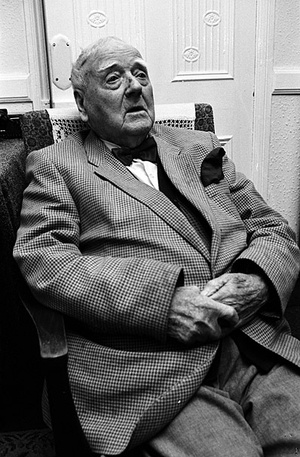
Sal
On the last Saturday of August, 1955, Sal just couldn't resist grabbing a checker magazine and walking over to the Beacon. He didn't expect anyone else from the Club to be there, but he'd be content to enjoy some of Deana's coffee and cake on his own. Deana was the proprietor of the Beacon and her desserts were the best in town.
He sat down in a small booth and was soon occupied with a cup of coffee and some of the games and problems in the August edition of All Checkers Digest.
He was deep into an article about the big July tournament in Las Vegas, which had drawn over a thousand players from all over North America, when he felt a tap on his shoulder.
"Hey, what are you doing here?" a voice said.

Louie the Flash
Sal looked up, and gosh-darn if it wasn't Louie from the Club!
"Could ask you the same," Sal said with a grin.
"I was painting the guest bedroom all morning," Louie said, "and my wife told me, 'Go treat yourself to something at the Beacon.' Well, couldn't pass that up now, could I?"

"Deana's got chocolate chip bars," Sal said. "Want to buy me one, Flash?" Louie had somehow gotten the nickname "Louie the Flash" and it had stuck.
"Me buy you one?" Louie replied. "Come on, dig a problem out of that there magazine and we'll see who buys!"
Sal chuckled. "Just happens there's one in here from my pal Brian," he said. "Coffee and cake on you when you can't win it?"
"Coffee and cake on you when I do win it," Louie said. But he wasn't really so sure. Brian always sent Sal problems, but the ones that he had published in a major checker magazine with nearly a million readers were usually pretty tough.
"Well, then, Flash old boy, here you go."
Sal set up the following position on his board.
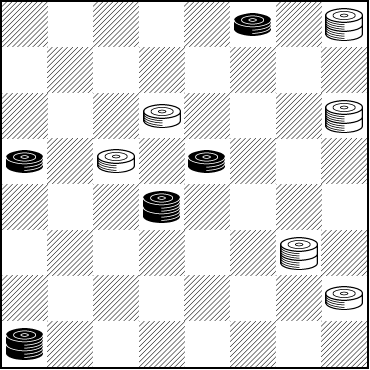
WHITE
White to Play and Win
W:WK4,10,K12,14,K24,28:B3,13,15,K18,K29
After a few minutes, Louie said, "You gotta be kidding me."
"Can't do it, can you?" Sal said. But then he noticed Louie's big grin. "What's the deal with the smile, Flash?"
Louie started to move the checkers.
Did Louie find the problem too hard or to easy? He probably wouldn't be grinning if he hadn't solved it. How about you? Will you grin or frown? See what you can do and then click on Read More for the solution and the conclusion of the story.![]()
Definitive Analysis of 11-Man Ballot

The eleven men above certainly aren't playing 11-man ballot or any other variety of checkers, though we'll bet many of them did surely play checkers in a slightly less risky environment.
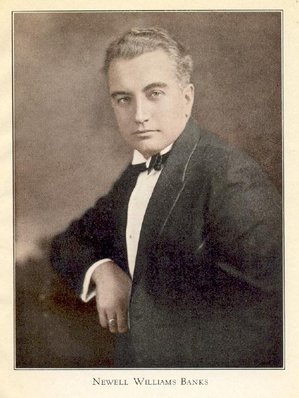
But today, our subject is indeed the 11-man variant of checkers. Created around 1907 by champion player Newell W. Banks, it provided an inventive alternative to the common "go as you please" (GAYP) style, in the hopes of lending the game fresh variety and reducing the number of draws.
In GAYP, of course, there are no restrictions on opening moves. Players indeed go where and as they please. The relatively short-lived "2 move restriction" style, in which the first move for both Black and White is chosen by lot, was played for a while in the early 20th century; and "3-move restriction" in which the 3-move opening sequence Black-White-Black is randomly selected, came just a bit later and is current today. (GAYP is also still played at the highest levels of the game.)
The 11-move ballot variant got some play and some attention but never really caught on, at least not until recently, and while 3-move restriction has been extensively analyzed, 11-move ballot has remained mostly new territory.
For a full description of 11-man ballot, you can see this link, but the basic idea is that one piece chosen at random is taken off the board on each side, and then the first Black and first White move are also chosen at random. There are some further rules and limitations, but that's the main idea. There are 2,500 independent ballots in this variation! Some are known to be dead lost (and are not played), many are clearly playable, and some are open to speculation.

Ed Gilbert
Photo Credit: Carol Gilbert
Until now. For Ed Gilbert and his mighty KingsRow computer engine have been very busy, and Mr. Gilbert has made yet another contribution to the game: he has analyzed and classified every last one of the 2,500 ballots, labeling each as won, lost or drawn for Black or White, and further, calculating a difficulty factor for all of them. This information is handily summarized in a series of tables (see links at the end of this article).
Ed has also prepared a special 11-man ballot computer opening book containing 1.1 million positions, which is now distributed with the latest download of KingsRow. He has made all of this material available free of charge on his website (again please see links at the end of this article).
11-man ballot will never be the same again.
What follows is a fairly detailed discussion of Ed's work. But first, to illustrate the depth of Ed's discoveries, take a look at the following position.
Remove 6 and 21; 12-16 22-18
WHITE

BLACK
Black to Play and Draw
B:W18,23,24,25,26,27,28,29,30,31,32:B1,2,3,4,5,7,8,9,10,11,16
This, gentle reader, is a draw. Yes, it is, requiring no less than 20 star moves on the part of Black. Ed ranks this as the toughest of all the 11-man ballots and we call it the toughest checker problem ever published.
Care to try it? You can access our no-spoilers animation here. Try to guess each Black star move and the strongest reply by White before you click the arrow to show the next move. If you can solve it, you're superhuman, but it's fun to try and will give you a real workout. If you'd rather just play through on a board or on your computer, you can click on Read More to see the list of moves.
And now let's let Ed describe his work in his own words, through a series of emails sent to us over the past few months. A bit earlier on in the process, Ed said this:

"I have finished the analysis work I've been doing on 11-man ballots.
"I have found a few more 11-man lost ballots. There are now 248 lost ballots identified by the opening book generator. This may be the exact right number, or perhaps I'm off by 1, I can't be absolutely sure, but it's been over a month of book expansion since the last lost ballot was identified, so I feel that the analysis is quite solid now. I read on the NC Checkers site that when they play an 11-man championship match, after selecting a ballot at random, the 2 players sometimes spend some time trying to determine if the ballot is playable or perhaps a loss. Maybe this analysis will at least be useful to simplify that part of the matches."
A little later on, Ed sent this update, wherein an additional ballot (the one diagrammed above) was found to be a draw rather than a white win, reducing the number of lost ballots to 247:
"Using a combination of engine matches and additional book expansion, I found that one of the 11-man openings that I had classified as a white win is actually a draw. It is ballot #2493, and a very difficult draw to be sure. When I updated the rating tables, this ballot went to the very top of the difficulty table with the highest difficulty figure of all the drawn ballots. It appears that for the first 20 moves, there is only one drawing move for black (when white plays the strongest attack)."
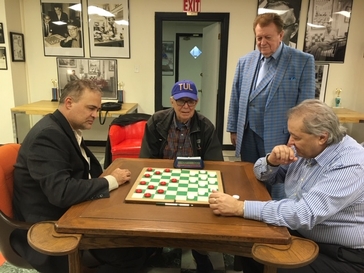
Finally, here are the details about how Ed computed difficulty rankings. To determine a reference for relative difficulty, Ed first re-analyzed the 3-move ballots and correlated various measures with the difficulty ratings assigned by Grandmaster Richard Pask and published on the ACF website (see link at bottom of article).
Warning: The following material is not for the faint of heart or the non-mathematical! (Note: The text below contains a small post-publication correction Ed sent us based on correspondence with Martin Fierz.)
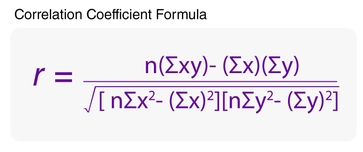
"Each position along the PV is visited, and a 5-second KingsRow search is done with KingsRow configured to use only an 8-piece endgame database. The sum of those search scores is the value used.
"By the way, I found that if I did the searches with a 10-piece database, the results did not correlate nearly as well as they do with 8-piece. Too many searches return 'database draw' using the 10-piece database, so too much heuristic information is lost that way. I should also mention that database draw search scores of +/-1 and repetition draw scores of +/-3 were given the value 0 during the PV sum process.
"'Match score difficulty' is the second rating value that is an independent input into the model. To get this value, a number of engine match games were played for each 11-man ballot. To be specific, each ballot was played for 96 games, KingsRow vs KingsRow, opening books off, 8-piece database, and blitz time controls of 0.1 seconds/move."
"This component of the model is based on a suggestion from Martin Fierz. I will paste exactly what he wrote to me, because I liked his reasoning and found it slightly amusing. He wrote, 'My feeling is that at 0.1s the engines are playing very well according to human standards, but not yet inhumanly well, so that this metric kind of approaches what strong human players would do when playing these ballots.'
"To turn the Black wins ('bwins'), White wins ('wwins'), and games into a ranking score, I used this logic:
if (bwins >= wwins)
rank = bwins / games
else
rank = -wwins / games
"I had previously tried other logic, like 'rank = (bwins + wwins) / games', but that metric by itself did not correlate as well with Richard Pask's ratings (for 3-move ballots). To put this into words, it seems that the Pask ratings are based primarily on his perception of how difficult it is for the weak side to play these ballots, and does not take into account that perhaps there are significant opportunities for the weak side to actually score a win. It didn't happen often, but you can see there are a few ballots where the weak side scored almost as many wins as the strong side.
"So we have these two rating values, PV sum and match score, and these were combined and a best fit to Pask's scaled ratings was found through linear regression. If you plot a best fit of each of these ratings to Pask's separately, you find that PV sum by itself has an R-squared value of 0.608.
"When the match score is used by itself to predict Pask's ratings, the R-squared value was much lower, something like 0.2. I also did this with the 'match score' ratings. So by themselves they would not provide a good model, but when combined it does increase the adjusted R-squared by nearly 0.1.
"The output of the linear regression module for the full model is the scaled ACF difficulty, and these coefficients are used directly to generate the 11-man difficulty ratings."
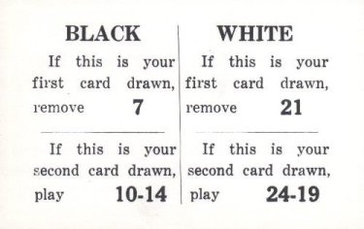
So there you have it. 11-man ballot has at long last been put on a solid footing based on detailed calculation and computer analysis. Is this the very last word on the topic? Ed himself would likely say that in checkers, the last word is never really in, but have we ever come a long way!
And some people think checkers is simple? After hundreds of years, we're still finding new ideas and exciting discoveries!
The Checker Maven thanks Ed Gilbert for the enormous privilege of presenting his work in this column. We hope Mr. Gilbert's ground-breaking efforts will serve to increase interest in 11-man ballot checkers, leading to more competition and even more analysis and publication.
Main link to Ed's work:
11-man ballot, descriptive page
The following links can also be reached from Ed's website but are given here for convenience.
Latest KingsRow which includes the 11-man ballot opening book
11-man ballot difficulty ratings in order of difficulty
11-man ballot difficult ratings in ballot number order
Reference rankings of 3-move opening difficulty (Richard Pask/ACF)
![]()
Give A Little, Get A Little

Exchanging gifts--- sometimes small, sometimes not so small--- is a long-standing tradition. Among family and friends, it makes no difference if we give a little more than we get, or get a little more than we give.
Not so, however, in our game of checkers. If we give, we'd better get back at least as much, if not more. and that leads us to this month's easy problem--- perhaps it isn't completely easy, but we've already given such a large hint that it should be simple enough. The position was provided by regular contributors Lloyd and Josh Gordon of Toronto.
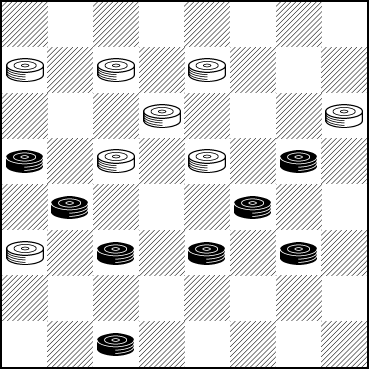
BLACK
Black to Play and Draw
B:W12,18,19,21,23,26,27,28:B3,9,10,11,14,16,17,20
Will you be able to resolve the interesting give and take? Give it a try, then take your mouse over to Read More to see the solution.![]()
